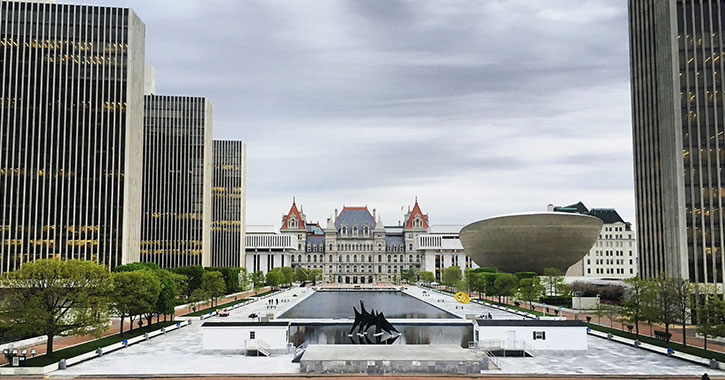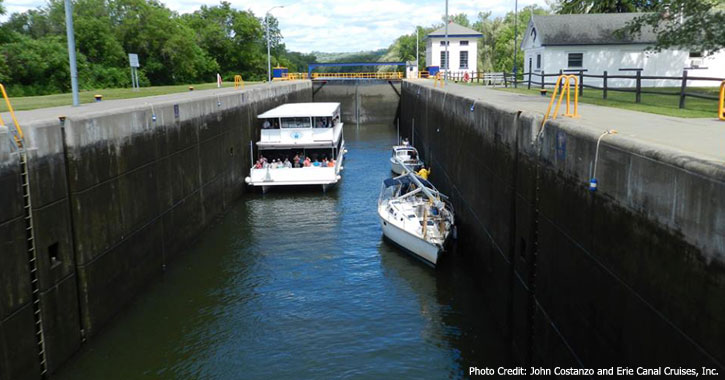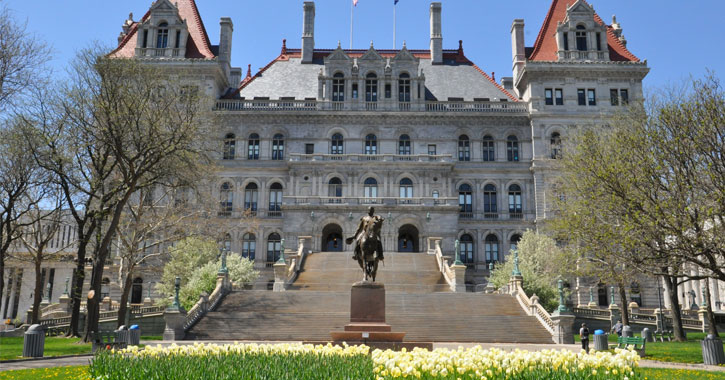Discover the History of Albany, New York
Settled in the early 1600s, the City of Albany combines its historical roots with visionary thinking empowered by hundreds of years as the governmental seat of New York State.

Colonial Times - 1800: The City's Beginning
The City of Albany's story begins with Fort Orange, which was established by the Dutch West India Company as a fur trading post in 1624. Prior to European settlement, the Tri-City area was inhabited by the Algonquian and Iroquois tribes.
Among the first European settlers at Fort Orange were the Walloons, who spoke French or were of French ancestry. More specifically, the Walloons came from the Spanish Netherlands (modern day Belgium and parts of other European countries).
Fort Orange consisted of a small detachment of soldiers from the Dutch West India Company, farmers, and other employees who conducted the main business transactions. However, in the following years, the trading post grew and settlers began to move north of Fort Orange to a new settlement that would be named Beverwyck.
In 1664, the settlement surrendered to the British, and King Charles II granted ownership of the territory to his brother James. Soon after, Beverwyck was renamed Albany. Then, in 1686, Albany was recognized as a city when Governor Thomas Dongan signed the Dongan Charter. As a result, Albany is still the oldest continuously chartered city in the country.
Though technically part of Britain's crown until the American Revolution, Dutch merchants continued to influence the city, and under Dutch guidance, Albany played an important role in maintaining communication between the French, British, and Native Americans.
Years later in 1754, the leaders of several colonies met in Albany and discussed Benjamin Franklin's Albany Plan of Union, which focused on the best defense against the French. During the French and Indian War, which lasted from 1754-1763 (officially declared in 1756), Albany was a key hub for military planning.
When the American Revolution (1765-1783) occurred, Albany was once again a central location and utilized as supply center, military base, and hospital for the Patriots. During the Revolution, Albany native Philip Livingston signed the Declaration of Independence in 1776. In 1797, after the British had lost control of the city, Albany became the official capital of New York State.
1800 - 1900: Travel by Land, Water, Rail & Underground

Throughout the 19th century, Albany started to grow as the number of transportation options increased. People were able to travel to and from the city by stagecoach and wagon, watercraft (including steamboats), and train.
In 1807, Robert Fulton established a steamboat line from New York City to Albany. By 1825, the Erie Canal was completed between Albany and Lake Erie, forming a continuous water route that enabled travel and the shipment of resources across long distances.
Soon after in 1831, a 16-mile railroad opened between Albany and Schenectady. The region’s railroad system continued to expand over the years, and the main line in Albany eventually connected to Buffalo and other communities in and outside New York State.
In addition to the actual railroad, and prior to the Civil War, local abolitionists were active in the Underground Railroad. Stephen Myers was at the forefront of the movement and acted as the "conductor" of the Underground Railroad in Albany. At the outbreak of the Civil War, Albany served as a major supply center.
Overall, the easy access to Albany resulted in population growth throughout the 19th century. Various groups traveled to and settled down in the area, particularly members of Irish, German, and Jewish communities.
1900 - Modern Times: Travel by Air, Urban Renewal & Historic Sites

Albany's airport was constructed in the 20th century and has the distinction of being the oldest municipal airport in the U.S. It originally started as an airstrip in Loudonville in 1908, but was then moved to Westerlo a year later. In 1928, Albany Mayor John Boyd Thacher II called for a new modern airport to be built in Colonie, the present day Albany International Airport.
While many historic Albany districts and buildings remain, the city has seen its fair share of urban renewal projects. One of the largest in American history started in the 1960s, when then New York Governor Nelson Rockefeller became the driving force behind the construction of the Empire State Plaza in the heart of Albany.
The Plaza project became a subject of controversy, as over 1,000 buildings were razed, around 7,000 people were forced to leave their homes due to eminent domain, and more than 300 businesses were closed. This topic is covered in a documentary titled "The Neighborhood That Disappeared," which often airs on WMHT, Albany's local PBS station.
The ultra-modern Plaza complex, designed by Wallace Harrison, the chief architect of New York City's Rockefeller Center, was completed in 1978. A walk through the complex will uncover one of the finest collections of modern art you will find outside of a museum. The Empire State Plaza Art Collection consists of paintings, sculptures, and tapestries. Visitors will also want to take the elevator to the top of the Corning Tower and check out the view from the 42nd floor observation deck.
The Plaza stands in direct contrast to the architecture of the Capitol Building, located on State Street. Completed in 1899, this building was inspired by the Hôtel de Ville in Paris. The Capitol is an eclectic blend of Gothic Revival, Romanesque, and Moorish influences due in part to the five different architects who played a role in its construction. Notable features in Albany's Capitol building are its massive staircases that are works of art, and the Senate Chamber, complete with 23-carat gold leaf on the walls, Italian marble, and massive fireplaces.
Some of the other attractions at the Empire State Plaza include the New York State Museum and The Egg, a stylistic performing arts venue that houses two theatres and features concerts and other special events.
Plus, did you know The Pride Center of the Capital Region in Albany is the oldest continuously operating LGBTQ Center in the United States? Established in 1970, the center has operated programs to meet the health and human service needs of the Capital Region's LGBTQ community.
All over Albany, local history exists in many shapes and forms. From historic buildings to cultural centers, Albany's history is alive and well.
See our Fast Facts page for general information and demographics.
Sources:
- https://www.newnetherlandinstitute.org/history-and-heritage/digital-exhibitions/a-tour-of-new-netherland/albany/fort-orange/
- http://exhibitions.nysm.nysed.gov//albany/loc/fortorange.html
- https://www.albanyny.gov/Government/CityHistory.aspx